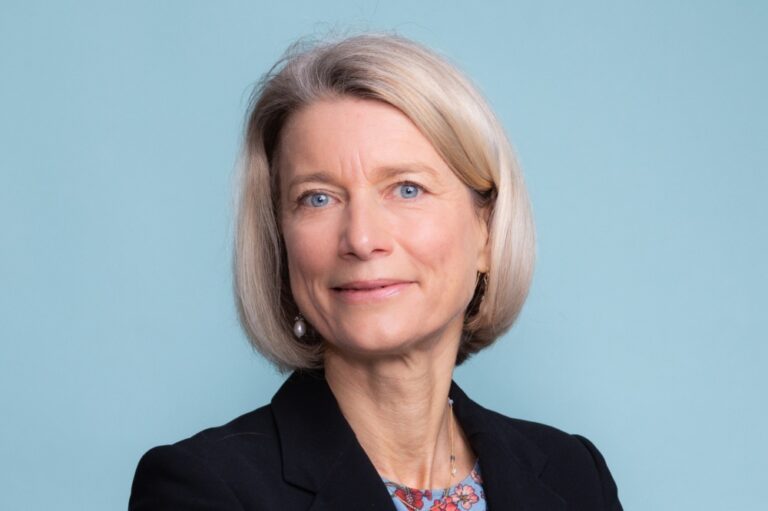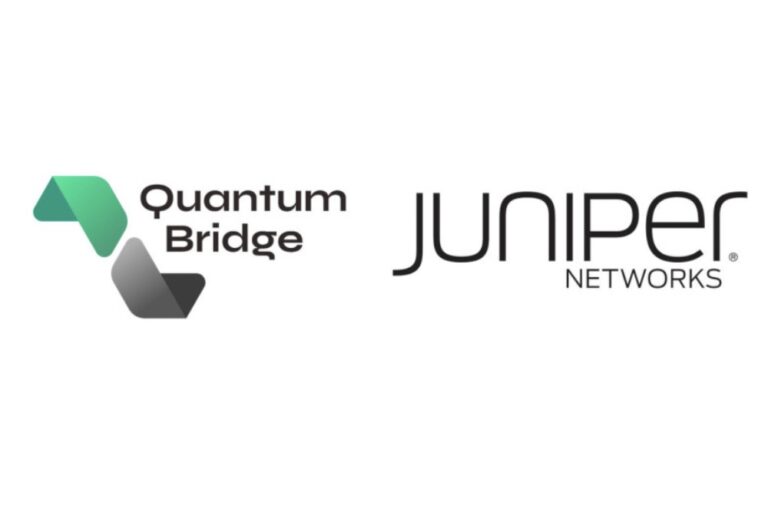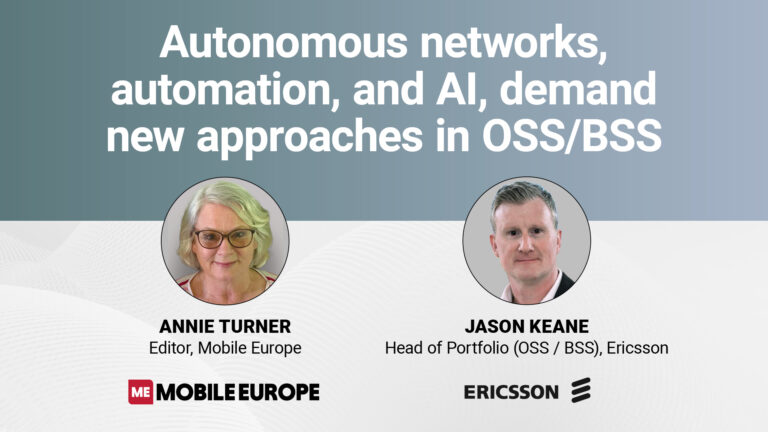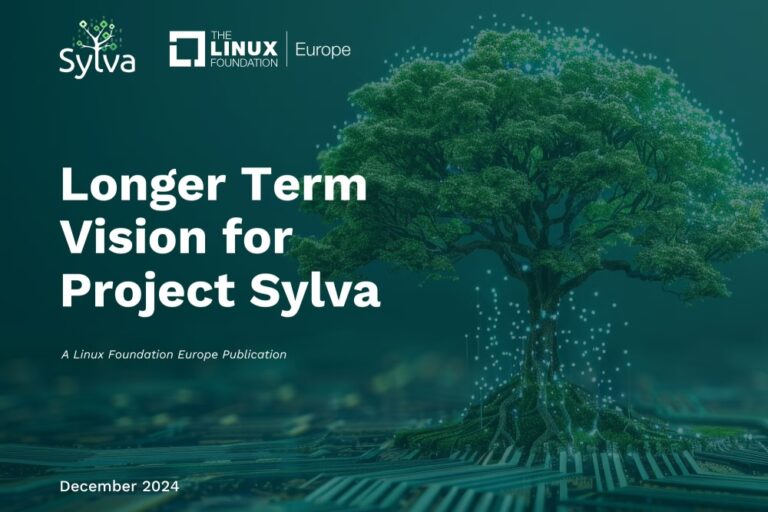NOTE: This is one of two interviews we recorded with Jason Keane on this topic - CLICK HERE to watch the other video.
Jason Keane, Head of Portfolio for OSS and BSS at Ericsson, talks about the evolution of autonomous networks, from replacing manual operations to intent-based networks, and how increasingly sophisticated automation creates new business opportunities.
Autonomous networks are progressing, Keane says, but it is a comprehensive goal, involving many elements and domains, from the RAN to the transport and core networks, plus the OSS and BSS. They must all work in harmony to achieve the ultimate goal of intent-based networks, enabled by full automation.
Keane explains, “I set an intention and a network automatically adjusts to meet that intent. It’s quite a large vision, a broad step from where we are today.”
He adds, “Ultimately, the reason you want to get on to being an autonomous network [is that] it allows you to improve operational efficiency within operations and within the business itself, so that you can focus on top line growth and the core value you’re bringing, not necessarily in running a technical system, but by delivering service to your customers.”
There are “clearly defined milestones and levels you can get to achieve this,” he adds, referring to TM Forum’s Autonomous Networks (AN) model. It is designed to help operators monitor and benchmark their progress, as he explains, from Levels 0 to 5, which is fully autonomous. In Ericsson’s experience, most operators are currently targeting Level 4.
Keane notes that automation is underway in parallel with operators modernising their architectures to around cloud native principles, which also contribute to dynamic scaling and management.
As the networks become increasingly complex, static automation, such as closed loop, is insufficiently sophisticated, whereas AI can generate if-then statements to provide the best response in the network. This is complemented by service orchestration and assurance, such as offered by Ericsson, to instantiate services and deal with faults dynamically.
Keane outlines the third critical element of the journey towards intent-based networks, APIs. They are essential for seamless integration between the various network components. Ericsson complies with TM Forum Open APIs, he says, and is also supporting and promoting them in a number of ways.
He gives advice about where and how to start, and use cases, and concludes with the encouraging view that, “When you start, it might look very long and very arduous… but each step the key for us and key for our customers – we bring business value. We bring more robust operation efficiency, or the opportunity of growing the top line that will keep the journey going.
This interview was sponsored by Ericsson. To learn more, visit: OSS/BSS evolution for successful 5G monetization – Ericsson
Transcript:
Lightly edited for clarity
<AT – Annie Turner> Hello and welcome. Today we are going to talk about autonomous networks, automation and AI, and how they are demanding new approaches in OSS and BSS.
I’m delighted to welcome Jason Keane, who’s Head of Portfolio for OSS and BSS at Ericsson, to talk to me about issues surrounding that topic.
Welcome, Jason.
<JK – Jason Keane> Thank you Annie.
<AT> Maybe we can start by you explaining to me in what ways autonomous networks, automation and AI, demand new approaches, and maybe why?
<JK> Sure. If you start with autonomous networks and what they are, because there’s a lot of hype and a lot of excitement in the industry about this.
I suppose at a very simple level, autonomous networks are a way to describe what you’d like to happen, and then the networks would simply comply and do what you want to happen.
Another word that sits on top of autonomous is intent, where you say – I set an intention and a network automatically adjusts that intent.
It’s quite a quite a large vision, or quite a broad step and vision from where we are today.
It’s journey the whole industry is taking, and there’s actually clearly defined milestones and levels to achieve this, but it is absolutely a journey.
What we see today with autonomous networks is as people progress, the more you realize that you need to actually do more. It’s actually quite a comprehensive vision.
But ultimately the reason you want to get on to being an autonomous network and move on that path is, it brings in a level of automation. It allows you to improve operational efficiency within your operations, within your business itself, so you can focus on top line growth and then your core value that you’re bringing, not necessarily running a technical system, but delivering service to your customers.
In terms of AI and what it can mean, there’s many different components across when we talk about autonomous networks. We have the RAN, we have the core, we have the transport function, we have the OSS, the BSS – which is my domain – and ultimately, all of these need to work in harmony.
They need to work together in alignment, passing the right information,
the context of the information together very quickly, very accurately and ultimately, that has to be relevant.
The glue that can help bring all of this together is artificial intelligence or generative artificial intelligence, and information underlying it such that you can no longer have to worry about manually configuring a system, or manually operating, or manually deploying it.
You simply set an intent and the system complies with it.
<AT> Interesting.
After such a long time of us talking about seamless and zero touch end to end operations, we are still, as you say, on the journey and very much so.
Networks are not autonomous yet. That means we’re still in the transition towards that goal.
How can we move from the old way of doing things to this new way?
<JK> I fully agree with you, we’ve been on the zero touch forever.
I think right now the tooling has reached a level of sophistication that we can get there.
When we talk about a transition state moving from not autonomous yet, the TM Forum have defined an autonomous network framework, which is very useful and it defines levels Zero to Five.
Zero is maybe not so interesting – everything is manual – to Five where it’s fully autonomous.
Most people are targeting level Four today because maybe that’s where the tooling can get to right now. And as we evolve as an industry with technology, we’ll get better.
But it’s a way that everybody can assess their progress towards it.
Ultimately, like any transformation, it’s a stepwise approach. But in the OSS and BSS space we are advancing with areas where the underlying infrastructure you simply have to move with cloud-based principles, cloud-native based principles.
In other words, you can scale up, down, left, right, dynamically as your business sees fit. This requires modernizing the architecture, you simply have to modernize it.
If you want to automate it, you want to scale it. You want to deliver the services. You want to let it self-manage. You have to modernize it.
The other thing as well is – the network doesn’t exist on its own.
When you look at, even throughout BSS and the RAN and anything else, there’s different components that will deliver different functionality and you want seamless integration between them.
For example, in Ericsson we comply with TM Forum Open APIs. That is as much for us to help be standard, compliant, as to allow our customers, to define the right way to integrate, to remove the complexities of integration.
I suppose what we’re actually trying to do with customers here is, we’re trying to change the engine of the car while driving. We’re driving down the road, and we’re asking to change the actual engine. You can’t do this big bang.
So it’s also okay to realize this is a journey we’ve got to get on.
But every step you take on the journey should move you towards the end goal of a fully autonomous network. It’s quite a complex area and a stepwise approach you need to take to get there.
<AT> Yes, the TM Forum model is really widely cited and many people find it really useful, as a benchmark as well as, setting goals.
As networks become more autonomous, and complexity increases, how are you going to manage that? It’s a bit of a conundrum, isn’t it?
Because we’re looking to autonomous networks to address complexity but in itself,
that’s quite a complex manoeuvre. How does that work?
<JK> It’s rather circular, isn’t it, which is a fair question.
I think the first thing is – the fundamentals of automation don’t go away. You just simply have to automate.
The problem we have with automation of course is, previous automation is quite static.
But ultimately, you’re right – they’re going to get more and more complex.
The reality is you can’t manage all that manually. You have to use automation tools
to automate tasks and this is a critical success factor for CSPs, for our customers they have to simply use it.
What’s different, though, with the automation is that previously when we’ve done automation, it’s been rather rigid, for example, in the parlance of developers, it’s an if-then statement. If this happens, then do this. If then this happens, then do this.
You can’t manually code that. You can’t statically do that for your entire network. It’s too complex.
In the automation this is where AI is helping. It can understand you saying – okay this is the situation I’m in, it’ll generate the if-then statement on the fly for you and figure out what is the best action I can take to move this to the next step.
The tooling has matured. For example, if we take our Service Orchestration and Assurance, which is a product we have in Ericsson, that actually turns on the service, instantiates to serve an assurance for you.
It can give differentiated connectivity in network slicing. It does that
rather simply. We said – I would like the service turned on. It’ll go on. It’ll turn on the elements. And if the elements themselves can’t be turned on because they’re busy, or they’re reserved, or they’re unavailable, it just doesn’t fail.
It asks – OK, maybe I have an order fallout here, maybe I have an issue here, what is the next step I take to deliver the service to the customer?
So even if it’s very complicated, the system takes the heavy activity out of making the service available.
And today we’re already automating service life cycles for many of our customers –Telia, Telstra, Rogers. So, we’re seeing it today.
Ultimately what it is for us, it’s about keeping the actual complexity hidden or pushing the complexity into the system which can self-manage itself.
<AT> Okay, so there’s a great example in service orchestration and assurance.
And I think these are topics that have really shot up in most operators’ agendas.
There’s so many ways in which we can expect to see automation and AI impact CSP’s businesses and operations.
Which areas or functions do you think hold the most promise?
<JK> Each of our customers will have a pain point area.
Where should they focus on this pain point area? But maybe I’ll give you some examples of where I see across the global organization, ones that are maybe sticking in our customers and make sense for our customers.
I suppose at the very top of it, in the core commerce area is where it actually starts, where you decide to buy something or you’re making the commercial offer.
Because, at the end of day, you need to sell something to make money.
One thing that’s helping here, or one of two things – is guided selling. What guided selling means is that I can go along instead of just saying to you, buy this service for X amount of money, I can upsell you. Actually, if you buy the service, I can give you a guaranteed SLA on the service or I can give you flexible pricing.
If you pick the service at this point in time, I can maximize the amount of revenue I can take for a customer.
Same issue is – I’ve got to sell you something you could buy. I need to make sure it happens and make sure it turns on.
One area you see is what we call order fallout. Order fallout is where the customer asks for something and for some reason, the network’s not able to turn it on. There’s an issue with the data, there’s an issue with the service. What we have is order fallout detection and prediction – before I even attempt to sell it to you, I make sure I can fulfil it and fulfil it in a timely fashion so your experience improves.
We see other examples coming in from customers in smart pricing. This is a new dimension that we see. Because what happens typically is static pricing.
In other words, the cost of doing something will be X amount of dollars per minute, per hour, per day, whatever else.
And for sure, we’re used to doing bundles at the weekend, you can get X amount of money off. But I can say to you – this is not peak time, so if you’d like to use a service here, I can give you a new price for this, I can incentivize you in smart pricing.
Other areas I see globally, this is the big area in this moment, is called intent-driven service management.
I see a huge interest in this. Why? Because this is the most complex and maybe cost demanding areas within a within our customers., So, if we can fix this and we can push forward to fix this, they will actually improve their operational efficiency such that they can help their business overall.
And this is how we’re helping customers today. We’re helping them saying – we have a tool called ESOA [Ericsson Service Orchestration and Assurance]. We’re intent-driven. We can do the service management. We can take the heavy lifting, do the heavy automation for you to instantiate your service.
Overall I suppose, Annie, it’s a journey, it’s a marathon not a sprint.
I think today it’s important that we keep it as manageable chunks of work, keep working on an impacting area more and more, until they come together and build up to be an autonomous network in the most useful way for you.
<AT> Okay, so really we’re thinking about building, automation in steps along the way and how we join those steps together.
This is the definition of a journey.
<JK> It is, absolutely. I think I think the thing is that while the journey we start might look very long and very arduous, each step is important, but in each step, the key for us and the key for our customers, we bring business value.
We bring that more robust operational efficiency or bring the opportunity of growing top line that will keep the journey going.
So you’re getting the benefits every time you take a step. It’s not a case of you having to wait till the whole thing is complete. That’s the real key thing when you’re thinking about investment and planning.
<AT> Jason, thank you very much indeed.
<JK> Thank you very much Annie.












